COME CELEBRATE ART! FOLLOWS ARE MANY EXCITING EXHIBITS AND ART EVENTS. CONTACT EACH VENUE DIRECTLY FOR CONFIRMATION AND TICKETING.
CURRENT EVENTS:
APRIL 26 – 28: ART IN BLOOM
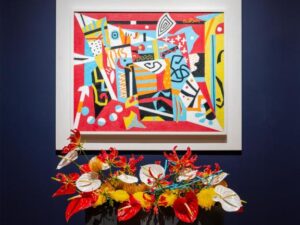 Image: Past arrangement at the Museum of Fine Arts, Boston, as part of Art in Bloom. © 2022 Estate of Stuart Davis / Licensed by VAGA at Artists Rights Society (ARS), NY The Museum of Fine Arts Boston again heralds the Spring with the return of their annual Art in Bloom event. For close to 50 years, this popular undertaking pairs works of art from the MFA’s collection—from ancient to contemporary—with floral arrangements created by New England-area garden clubs and professional designers. Forty five interpretive arrangements highlight this year’s celebration. In addition, the museum is offering master classes with florist Semia Dunne as well as an exclusive viewing of Art in Bloom for Museum members and their guests on April 27th. Art in Bloom launches at the Museum on Thursday, April 25 with a preview of freshly installed arrangements. Private group tours will begin on Friday morning for which advance registration is required. Throughout the weekend, included with Museum admission, visitors can enjoy free guided tours of arrangements throughout the galleries. Tickets and reservations for private group tours are available beginning March 5th while tickets for master classes are available beginning April 2nd on the museum’s website. Art in Bloom is presented by the MFA Associates, a group of dedicated volunteers who create the Museum’s flower arrangements throughout the year. Art in Bloom is supported by Arbella Insurance Foundation and Yellow Wood Partners. For tickets as well as more information, visit www.mfa.org
Image: Past arrangement at the Museum of Fine Arts, Boston, as part of Art in Bloom. © 2022 Estate of Stuart Davis / Licensed by VAGA at Artists Rights Society (ARS), NY The Museum of Fine Arts Boston again heralds the Spring with the return of their annual Art in Bloom event. For close to 50 years, this popular undertaking pairs works of art from the MFA’s collection—from ancient to contemporary—with floral arrangements created by New England-area garden clubs and professional designers. Forty five interpretive arrangements highlight this year’s celebration. In addition, the museum is offering master classes with florist Semia Dunne as well as an exclusive viewing of Art in Bloom for Museum members and their guests on April 27th. Art in Bloom launches at the Museum on Thursday, April 25 with a preview of freshly installed arrangements. Private group tours will begin on Friday morning for which advance registration is required. Throughout the weekend, included with Museum admission, visitors can enjoy free guided tours of arrangements throughout the galleries. Tickets and reservations for private group tours are available beginning March 5th while tickets for master classes are available beginning April 2nd on the museum’s website. Art in Bloom is presented by the MFA Associates, a group of dedicated volunteers who create the Museum’s flower arrangements throughout the year. Art in Bloom is supported by Arbella Insurance Foundation and Yellow Wood Partners. For tickets as well as more information, visit www.mfa.org
##########################################################################
PEABODY ESSEX MUSEUM
For complete museum and exhibition details visit www.pem.org
THROUGH JUNE 9: OUR TIME ON EARTH
 Victoria Vesna, Noise Aquarium (detail), 2022. Installation view of the Our Time on Earth exhibition at the Barbican Centre. © Danann Breathnach Photography. The Peabody Essex Museum (PEM) at 161 Essex St. in Salem, invites you on a transformative journey to reimagine your connection with our living planet The large-scale exhibition, enjoying its U.S. Debut, is organized by the Barbican Centre in London, with Guest Curators Franklin Till and presented as part of PEM’s Climate + Environment Initiative It promises to illuminate a path towards a more sustainable future through innovative artworks and immersive experiences. The exhibition celebrates the power of our global creativity to transform the conversation around the climate emergency. Visionary artists, designers, scientists, technologists and changemakers hailing from 12 countries will captivate visitors with their crafted collaboration of installations. Approach a dinner table set for a fox, a wasp and other unconventional guests; envision the microscopic foundations of life by diving into a virtual ocean surrounded by magnified plankton; and peer through the layers of a giant Kapok tree to visualize how trees act as a living bridge between soil and sky. Jane Winchell, the Sarah Fraser Robbins Director of PEM’s Dotty Brown Art & Nature Center stated,, “This exhibition invites us to imagine ways that art, design and science together can help us envision a positive future for our planet.” She continued, “Technology has brought us closer than ever before to understanding how nature functions and how Indigenous ecological perspectives reconnect us to our roots and inform solutions for the climate emergency.” The exploration of innovative design solutions for harmonious coexistence with nature takes center stage in The Symbiocene, a collaboration between designer and author Julia Watson, and architect and sustainability engineer Smith Mordak and Indigenous communities in Iraq, India and Bali. This project envisions what’s possible when we leverage Indigenous and nature-based technologies to create symbiotic urban environments.
Victoria Vesna, Noise Aquarium (detail), 2022. Installation view of the Our Time on Earth exhibition at the Barbican Centre. © Danann Breathnach Photography. The Peabody Essex Museum (PEM) at 161 Essex St. in Salem, invites you on a transformative journey to reimagine your connection with our living planet The large-scale exhibition, enjoying its U.S. Debut, is organized by the Barbican Centre in London, with Guest Curators Franklin Till and presented as part of PEM’s Climate + Environment Initiative It promises to illuminate a path towards a more sustainable future through innovative artworks and immersive experiences. The exhibition celebrates the power of our global creativity to transform the conversation around the climate emergency. Visionary artists, designers, scientists, technologists and changemakers hailing from 12 countries will captivate visitors with their crafted collaboration of installations. Approach a dinner table set for a fox, a wasp and other unconventional guests; envision the microscopic foundations of life by diving into a virtual ocean surrounded by magnified plankton; and peer through the layers of a giant Kapok tree to visualize how trees act as a living bridge between soil and sky. Jane Winchell, the Sarah Fraser Robbins Director of PEM’s Dotty Brown Art & Nature Center stated,, “This exhibition invites us to imagine ways that art, design and science together can help us envision a positive future for our planet.” She continued, “Technology has brought us closer than ever before to understanding how nature functions and how Indigenous ecological perspectives reconnect us to our roots and inform solutions for the climate emergency.” The exploration of innovative design solutions for harmonious coexistence with nature takes center stage in The Symbiocene, a collaboration between designer and author Julia Watson, and architect and sustainability engineer Smith Mordak and Indigenous communities in Iraq, India and Bali. This project envisions what’s possible when we leverage Indigenous and nature-based technologies to create symbiotic urban environments.
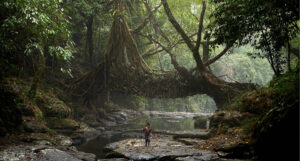 Living Root Bridge of The Khasi, Mawlynnong village, India. © Amos Chapple (originally published in Julia Watson, Lo-TEK. Design by Radical Indigenism, 2019). In Queer Ecology, Colombian biologist Brigitte Baptiste collaborates with the Institute of Digital Fashion to create a shared collective experience that prompts reflection on what lessons humanity can glean from nature’s inherent gender fluidity. By looking at how nature embodies queerness, this piece encourages visitors to witness their singular identities dissolving into matter, transcending the confines of the physical body and societal, binary labels. Sonic Waterfall, a captivating sound and light installation by Silent Studios (Nathan Prince and Liam Paton), offers a restorative sonic environment that encourages reflection, so we can engage in potential change. Trevor Smith, PEM’s Curator of the Present Tense Initiative and Associate Director of Multisensory Experience, notes that “Our Time on Earth celebrates the power of global creativity to transform the conversation around the climate crisis and open portals to a shared future, in which the planet and its people flourish together. To that end, I am delighted that the exhibition itself is built from natural and sustainable materials to minimize its carbon footprint.” Just as PEM is working to mitigate its own environmental impacts through its Climate + Environment Initiative, they extend an invitation for visitors to participate in creating a shared sustainable future in the PEM-generated “Be the Change” zone of the exhibition. This area was created in collaboration with Rare’s Climate Culture Boston. Visitors can explore ideas shared by others on the collective response wall, choose an action step at the “Count Us In” station and have an empowering climate conversation guided by question cards. This zone will also host regularly scheduled activations by local and regional climate and environment advocates, including Mass Audubon’s Youth Climate Leadership Program and Rare’s Climate Culture Boston team. For more information surrounding this exciting and uniquely wonderful exhibition, visit www.pem.org
Living Root Bridge of The Khasi, Mawlynnong village, India. © Amos Chapple (originally published in Julia Watson, Lo-TEK. Design by Radical Indigenism, 2019). In Queer Ecology, Colombian biologist Brigitte Baptiste collaborates with the Institute of Digital Fashion to create a shared collective experience that prompts reflection on what lessons humanity can glean from nature’s inherent gender fluidity. By looking at how nature embodies queerness, this piece encourages visitors to witness their singular identities dissolving into matter, transcending the confines of the physical body and societal, binary labels. Sonic Waterfall, a captivating sound and light installation by Silent Studios (Nathan Prince and Liam Paton), offers a restorative sonic environment that encourages reflection, so we can engage in potential change. Trevor Smith, PEM’s Curator of the Present Tense Initiative and Associate Director of Multisensory Experience, notes that “Our Time on Earth celebrates the power of global creativity to transform the conversation around the climate crisis and open portals to a shared future, in which the planet and its people flourish together. To that end, I am delighted that the exhibition itself is built from natural and sustainable materials to minimize its carbon footprint.” Just as PEM is working to mitigate its own environmental impacts through its Climate + Environment Initiative, they extend an invitation for visitors to participate in creating a shared sustainable future in the PEM-generated “Be the Change” zone of the exhibition. This area was created in collaboration with Rare’s Climate Culture Boston. Visitors can explore ideas shared by others on the collective response wall, choose an action step at the “Count Us In” station and have an empowering climate conversation guided by question cards. This zone will also host regularly scheduled activations by local and regional climate and environment advocates, including Mass Audubon’s Youth Climate Leadership Program and Rare’s Climate Culture Boston team. For more information surrounding this exciting and uniquely wonderful exhibition, visit www.pem.org
THROUGH JULY 7: ETHIOPIA AT THE CROSSROADS
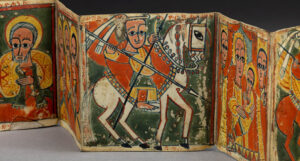 Artist in Ethiopia, Sensul (Folding icons) in original embossed leather case (detail), 15th-early 16th century. Parchment, pigments, and leather. Gift of Charles R. and Elizabeth C. Langmuir, 1979. E67892. Peabody Essex Museum. Photo by Kathy Tarantola/PEM. Aïda Muluneh, Addis Neger, from the Mirror of the Soul series, 2019. Inkjet print. Museum purchase by exchange. 2023.33.4. Peabody Essex Museum. Courtesy of the artist. © Aïda Muluneh. The Peabody Essex Museum at 161 Essex St. in Salem celebrates the artistic traditions of Ethiopia with this extraordinary exhibition. Utilizing more than 200 objects, including painted religious icons, illuminated manuscripts, gospel books, coins, metalwork and carvings that have been paired with works by renowned contemporary Ethiopian artist, the exhibition explores nearly 2,000 years of Ethiopian art and culture from their Origen to present day. Ethiopia at the Crossroads is co-organized by the Peabody Essex Museum, the Walters Art Museum, and the Toledo Museum of Art. The exhibition is made possible by two major grants from the National Endowment for the Humanities: Democracy demands wisdom and by a grant from the Institute of Museum and Library Services (MA-253352-OMS-23). The exhibition at PEM is made possible by the generosity of Carolyn and Peter S. Lynch and The Lynch Foundation and The Gladys Krieble Delmas Foundation. We also thank James B. and Mary Lou Hawkes, Chip and Susan Robie, and Timothy T. Hilton as supporters of the Exhibition Innovation Fund. We recognize the generosity of the East India Marine Associates of the Peabody Essex Museum. Any views, findings, conclusions, or recommendations expressed in this exhibition do not necessarily reflect those of the National Endowment for the Humanities. For more information, visit www.pma.org
Artist in Ethiopia, Sensul (Folding icons) in original embossed leather case (detail), 15th-early 16th century. Parchment, pigments, and leather. Gift of Charles R. and Elizabeth C. Langmuir, 1979. E67892. Peabody Essex Museum. Photo by Kathy Tarantola/PEM. Aïda Muluneh, Addis Neger, from the Mirror of the Soul series, 2019. Inkjet print. Museum purchase by exchange. 2023.33.4. Peabody Essex Museum. Courtesy of the artist. © Aïda Muluneh. The Peabody Essex Museum at 161 Essex St. in Salem celebrates the artistic traditions of Ethiopia with this extraordinary exhibition. Utilizing more than 200 objects, including painted religious icons, illuminated manuscripts, gospel books, coins, metalwork and carvings that have been paired with works by renowned contemporary Ethiopian artist, the exhibition explores nearly 2,000 years of Ethiopian art and culture from their Origen to present day. Ethiopia at the Crossroads is co-organized by the Peabody Essex Museum, the Walters Art Museum, and the Toledo Museum of Art. The exhibition is made possible by two major grants from the National Endowment for the Humanities: Democracy demands wisdom and by a grant from the Institute of Museum and Library Services (MA-253352-OMS-23). The exhibition at PEM is made possible by the generosity of Carolyn and Peter S. Lynch and The Lynch Foundation and The Gladys Krieble Delmas Foundation. We also thank James B. and Mary Lou Hawkes, Chip and Susan Robie, and Timothy T. Hilton as supporters of the Exhibition Innovation Fund. We recognize the generosity of the East India Marine Associates of the Peabody Essex Museum. Any views, findings, conclusions, or recommendations expressed in this exhibition do not necessarily reflect those of the National Endowment for the Humanities. For more information, visit www.pma.org
THROUGH JULY 20: BATS!
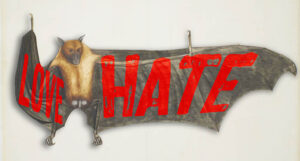 Tony Rubino, Love Hate Bat, 2019. Acrylic on canvas. Courtesy of the artist. The Peabody Essex Museum (PEM) presents Bats! — live and up close — in a multisensory exhibition that explores the wondrous world of bats and our connections with them. As the only mammals that can truly fly, bats have developed a host of superpowers that benefit both humans and habitats around the world. Yet bats remain shrouded in mystery and are often misunderstood.
Tony Rubino, Love Hate Bat, 2019. Acrylic on canvas. Courtesy of the artist. The Peabody Essex Museum (PEM) presents Bats! — live and up close — in a multisensory exhibition that explores the wondrous world of bats and our connections with them. As the only mammals that can truly fly, bats have developed a host of superpowers that benefit both humans and habitats around the world. Yet bats remain shrouded in mystery and are often misunderstood.
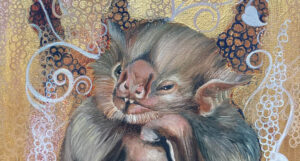 Resa Blatman, Small Bat Portrait 1 (detail), 2008. Oil on panel. Courtesy of the artist. This is a wonderful opportunity to assuage your fears and learn all about those strange creatures. Through the run of the exhibition, visitors can meet and peer into the lives of a small colony of Egyptian fruit bats that will be in residence at the museum. Accompanied by PEM collection objects, contemporary artworks, pop culture items and interactive zones, these furry ambassadors will teach visitors about the unique biology of bats and the vital role they play in our lives, ecologically, culturally and as inspiration for technological advances. “From images of Batman cartoons to symbols in ancient Chinese art, bats have long held cultural meaning across the world,” said Jane Winchell, PEM’s Sarah Fraser Robbins Director of the Dotty Brown Art & Nature Center. “Often misunderstood and maligned, bats have been associated with the underworld, magic, superstition and been symbols of both good and evil. As human activity continues to threaten bats and encroach on their natural habitats, it is increasingly urgent that we gain a more full understanding of these remarkable creatures. My hope is that visitors will come .away with a deeper and more complex understanding of our friends in the night sky.” Bats!, organized by and produced by ExplorationWorks! and Build 4 Impact Inc., features original content generated by PEM and works by contemporary artists Resa Blatman, Michael Brolly, Nick Demakes, Juan Nicolás Elizalde, Steve Hollinger, Tony Rubino, David Yann Robert, Rebecca Saylor Sack, Jeffrey Veregge, Michael LaFosse and Richard L. Alexander.
Resa Blatman, Small Bat Portrait 1 (detail), 2008. Oil on panel. Courtesy of the artist. This is a wonderful opportunity to assuage your fears and learn all about those strange creatures. Through the run of the exhibition, visitors can meet and peer into the lives of a small colony of Egyptian fruit bats that will be in residence at the museum. Accompanied by PEM collection objects, contemporary artworks, pop culture items and interactive zones, these furry ambassadors will teach visitors about the unique biology of bats and the vital role they play in our lives, ecologically, culturally and as inspiration for technological advances. “From images of Batman cartoons to symbols in ancient Chinese art, bats have long held cultural meaning across the world,” said Jane Winchell, PEM’s Sarah Fraser Robbins Director of the Dotty Brown Art & Nature Center. “Often misunderstood and maligned, bats have been associated with the underworld, magic, superstition and been symbols of both good and evil. As human activity continues to threaten bats and encroach on their natural habitats, it is increasingly urgent that we gain a more full understanding of these remarkable creatures. My hope is that visitors will come .away with a deeper and more complex understanding of our friends in the night sky.” Bats!, organized by and produced by ExplorationWorks! and Build 4 Impact Inc., features original content generated by PEM and works by contemporary artists Resa Blatman, Michael Brolly, Nick Demakes, Juan Nicolás Elizalde, Steve Hollinger, Tony Rubino, David Yann Robert, Rebecca Saylor Sack, Jeffrey Veregge, Michael LaFosse and Richard L. Alexander.
Let’s go Batty and visit the Box Pop-Up Shop at 135 Essex Street, right next door in PEM’s Connect building! There you can discover various Bat-themed items ranging from Bat houses, that provide a secure roost site for bats in your backyard, to Batgirl T-shirts. We will also showcase Bat-inspired pieces crafted by local artists such as Georgia Wrenn, Jade Gedeon, Nick Demakes, and more. A Bat Public Art Installation by Maia Mattson can be found at 179 Essex Street.
Salem’s 2022 Public Artist in Residence, Maia Mattson will show her Bats! (And Botany) that she has created using plant dyed silk, paper mache and dried florals to explore the symbiotic and essential relationship between bats and botany. Bats rely on native plant species, whether those plants serve as the bats’ food (for nectar-feeding and fruit eating species) or as nourishment for an insect meal. Both bats and native plant species are threatened due to continued habitat disturbance from urbanization and human impact. Both need support in order to survive these changes. Next time you slap that bug away, remember that bats eat the bugs we hate. Stylistically, this installation appears delicate and playful – plants and bats encircle each other gracefully. The botanical elements hang atmospherically within the display. However, there is also a precarious nature to these choices, an inherent fragility and uneasy balance within the beauty. Learn more and follow the artist on social media @_robbersdaughter_ For more information visit www.pem,org
THROUGH JAN. 3, 2027: ON THIS GROUND …BEING AND BELONGING IN AMERICA

The Peabody Essex Museum located at 161 Essex St. in Salem is opening for the first time, this long term retrospective that surrounds a blend of Native American art and and art from their American collections. More than 250 historical and contemporary works have been extracted from the museum’s vast personal collections, These works of art and artifacts span over more than 10,000 years offering a range of voices, actually modes of expression gleaned from all cultures., The media presented includes sculpture, paintings, textiles and costumes, furniture, decorative arts, works on paper, installations, photography, video, and a re-envisioned period room. All these help to place in context what it means to belong to a community, a place, a family and a nation that has routinely been expressed through numerous works manifested in diverse culture. On This Ground responds to the urgent needs of our time for individuals to embrace the understanding and necessity of community. This is provided with this unique opportunity to express the complexity of our combined histories. By doing so it strives to focus on a future that hopefully will bring more connection and empathy within the multiple cultures. Lynda Roscoe Hartigan, PEM’s Rose-Marie and Eijk van Otterloo Executive Director and CEO stated, “Placing these two significant collections in direct dialogue and giving them equal emphasis in a gallery space at this scale is unprecedented among American museums and underscores that the American experience is unimaginable without the inclusion of Native American art, history and culture.” Thus this exhibition helps us understand what it means to belong to family, community, and this place we now call America. By bringing two extraordinary collections of Native American and American art together for the first time in our institution’s history the installation will be responsive to these urgent times by giving our public an opportunity to grapple with the links, continuities, and disjunctions of our complex histories in America in order to shape a more connected and empathetic present and future.” The lead sponsorship is provided by The Henry Foundation, a leader in art funding since 1982. Additional generous support is provided by the TERRA Foundation, The Ellen and Stephen Hoffman Endowment for the Native American Art Department and The Andrew W. Mellon Foundation. In addition PEM gratefully acknowledges the support of the Native American Fellowship Program. For more information visit www.pem.org
ONGOING: FASHION AND DESIGN GALLERY
 The Peabody Essex Museum (PEM) has reopened this stunning exhibition which now features the influence of Boston Entrepreneur, Yolanda Cellucci. In 1968, entrepreneur Yolanda Cellucci entered Boston’s fashion scene and changed it forever. The city’s retail fashion scene at the time was robust, so Cellucci forged a business model focused on women’s wear and self-care in a holistic, head-turning way. Her shop Yolanda’s, based in Waltham, Massachusetts, became a hotspot for lavish evening and wedding ensembles. In addition to offering high-profile American and international designs, including pieces by Hollywood favorite Bob Mackie, the store provided style consultations, personal shopping, cosmetology services and a day spa with light refreshments — all under one roof. Throughout the late 20th century, “Yolanda’s” became a household name throughout the region and a watchword for glitz and glamor.
The Peabody Essex Museum (PEM) has reopened this stunning exhibition which now features the influence of Boston Entrepreneur, Yolanda Cellucci. In 1968, entrepreneur Yolanda Cellucci entered Boston’s fashion scene and changed it forever. The city’s retail fashion scene at the time was robust, so Cellucci forged a business model focused on women’s wear and self-care in a holistic, head-turning way. Her shop Yolanda’s, based in Waltham, Massachusetts, became a hotspot for lavish evening and wedding ensembles. In addition to offering high-profile American and international designs, including pieces by Hollywood favorite Bob Mackie, the store provided style consultations, personal shopping, cosmetology services and a day spa with light refreshments — all under one roof. Throughout the late 20th century, “Yolanda’s” became a household name throughout the region and a watchword for glitz and glamor.
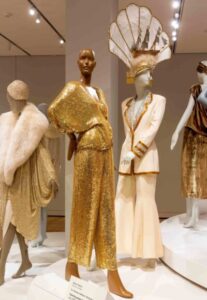 Fashions from Yolanda Cellucci’s collection In 2021, Cellucci generously donated her collection of 57 works of fashion and accessories to PEM, along with archival photographs and materials related to the legacy of Yolanda’s. “PEM is honored to be the steward of this singular and highly memorable chapter of fashion history,” said Petra Slinkard, PEM’s Director of Curatorial Affairs and The Nancy B. Putnam Curator of Fashion and Textiles. “With an eye for all things dazzling, Yolanda Cellucci influenced so many women’s lives by encouraging them to embrace their own power and unapologetically command attention as they stepped out into the world,” added Paula Richter, PEM’s Curator overseeing the Yolanda Cellucci collection.
Fashions from Yolanda Cellucci’s collection In 2021, Cellucci generously donated her collection of 57 works of fashion and accessories to PEM, along with archival photographs and materials related to the legacy of Yolanda’s. “PEM is honored to be the steward of this singular and highly memorable chapter of fashion history,” said Petra Slinkard, PEM’s Director of Curatorial Affairs and The Nancy B. Putnam Curator of Fashion and Textiles. “With an eye for all things dazzling, Yolanda Cellucci influenced so many women’s lives by encouraging them to embrace their own power and unapologetically command attention as they stepped out into the world,” added Paula Richter, PEM’s Curator overseeing the Yolanda Cellucci collection.
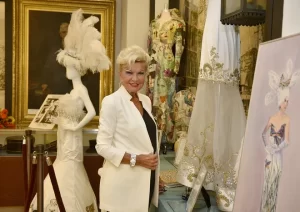 Yolanda Cellucci Throughout her career, Cellucci hosted fashion shows and galas, showcasing her merchandise and raising funds for charities focused on healthcare, the arts and education. Events at Yolanda’s influenced Boston’s society pages for decades. Now in her 80s, Cellucci continues to make an impression through her cable access TV show, a recently published autobiography Beyond the Glitz and Glamour and a series of books written in her daughter’s memory, Lindy Lou and her Dancing Shoes. PEM’s Fashion and Design gallery, located on the third floor of the museum’s new wing, now boasts more than 100 fresh works from the museum’s global fashion and textile collection, including nearly 40 recent acquisitions that spotlight the vibrant and flamboyant collection of Yolanda.. PEM’s Fashion & Design Gallery also features more than 180 examples of contemporary and historic dress, as well as textiles, accessories, sculpture, studio glass and decorative arts and furniture drawn from PEM’s vast and storied collection. Various objects will be rotated into the gallery such as thirteen new ensembles in the Carl & Iris Barrel Apfel Gallery.;
Yolanda Cellucci Throughout her career, Cellucci hosted fashion shows and galas, showcasing her merchandise and raising funds for charities focused on healthcare, the arts and education. Events at Yolanda’s influenced Boston’s society pages for decades. Now in her 80s, Cellucci continues to make an impression through her cable access TV show, a recently published autobiography Beyond the Glitz and Glamour and a series of books written in her daughter’s memory, Lindy Lou and her Dancing Shoes. PEM’s Fashion and Design gallery, located on the third floor of the museum’s new wing, now boasts more than 100 fresh works from the museum’s global fashion and textile collection, including nearly 40 recent acquisitions that spotlight the vibrant and flamboyant collection of Yolanda.. PEM’s Fashion & Design Gallery also features more than 180 examples of contemporary and historic dress, as well as textiles, accessories, sculpture, studio glass and decorative arts and furniture drawn from PEM’s vast and storied collection. Various objects will be rotated into the gallery such as thirteen new ensembles in the Carl & Iris Barrel Apfel Gallery.;
 Shoes from PEM’s renowned footwear collection…the largest in the U.S.; works that focus on China’s influence and fashion’s use of the iconic dragon symbol,; objects that speak to the notions of intimidation and empowerment such as fashions by Donna Karan, a rare Salem Zouave uniform, a Nick Cave Soundsuit and the likeness of a Samurai warrior; and a section looking at body modification that includes an 18th century corset paired with a work from the Fall/Winter 2016 collection from the Parisian fashion house;, along with never before-exhibited jewelry from India, Singapore, Myanmar and Indonesia. For more information visit www.pem.org
Shoes from PEM’s renowned footwear collection…the largest in the U.S.; works that focus on China’s influence and fashion’s use of the iconic dragon symbol,; objects that speak to the notions of intimidation and empowerment such as fashions by Donna Karan, a rare Salem Zouave uniform, a Nick Cave Soundsuit and the likeness of a Samurai warrior; and a section looking at body modification that includes an 18th century corset paired with a work from the Fall/Winter 2016 collection from the Parisian fashion house;, along with never before-exhibited jewelry from India, Singapore, Myanmar and Indonesia. For more information visit www.pem.org
IN ADDITION TO THE ABOVE THERE ARE NUMEROUS VIBRANT AND DIVERSE ONGOING EXHIBITIONS ON DISPLAY AT THE PEM! (www.pem.org)
>>>>>>>>>>>>>>>>>>>>>>>>>>>>>>>>>>>>>>>>>
MUSEUM OF FINE ARTS BOSTON
For complete museum and exhibition details visit www.mfa.org
APRIL 13 – SEPT. 2: DRESS UP
 Henri Cartier-Bresson, Foley’s Department Store, Houston, Texas, USA, 1957. Gelatin silver print. Gift of Charles T. and Alma Isaacs. © Henri Cartier-Bresson/Magnum Photos. The MFA Boston presents in their Henry and Lois Foster Gallery located in the Linde Family Wing for Contemporary Arts this fun profile of what we have done throughout the centuries, almost every day of our lives. We get dressed. Our choice of dress can make a political statement, express a mood, communicate personal identities, or manipulate another party. Through more than 100 works extracted from the 20th as well as 21st century collections belonging to the MFA, the exhibition includes clothing, jewelry, and other accessories, along with illustrations, and photographs. By utilizing these items this exhibit explores adornment and its role in the creation of a proverbial “look”. It becomes a celebration of styles by fashion icons such as Alexander McQueen, Bob Mackie, John Galliano, and Oscar de la Renta. In addition, the focus of this retrospect includes the importance of accessorizing with jewelry. So fabulous jewelry designers like Hattie Carnegie, Elsa Poretti and House of Lanvin are spotlighted. And, not to forget lovers of handbags, hats and of course shoes, the footwear designer, such as Thom Solo is included. Illustrations by Cecil Beaton, Henri Cartier-Bresson and Martin Parr, as well as portraits of Madonna by Herb Ritts and Grace Kelly by Yousuf Karsh, further enhance the exhibit. The body of the exhibition has been grounded in the debut of a major gift of vintage costume jewelry from the important collection acquired by the Museum in 2018 and 2019 from Toronto-based collector Carole Tanenbaum. There are 60 pieces on view that were created by incorporating inexpensive materials such as plastics, base metals, gold plating, imitation pearls, and glass gems. Despite being mass-produced, this jewelry provided an attractive and unique look. Thus this jewelry industry quickly evolved into becoming a popular complement to the then rapidly growing ready-to-wear fashion industry in the 20th century.
Henri Cartier-Bresson, Foley’s Department Store, Houston, Texas, USA, 1957. Gelatin silver print. Gift of Charles T. and Alma Isaacs. © Henri Cartier-Bresson/Magnum Photos. The MFA Boston presents in their Henry and Lois Foster Gallery located in the Linde Family Wing for Contemporary Arts this fun profile of what we have done throughout the centuries, almost every day of our lives. We get dressed. Our choice of dress can make a political statement, express a mood, communicate personal identities, or manipulate another party. Through more than 100 works extracted from the 20th as well as 21st century collections belonging to the MFA, the exhibition includes clothing, jewelry, and other accessories, along with illustrations, and photographs. By utilizing these items this exhibit explores adornment and its role in the creation of a proverbial “look”. It becomes a celebration of styles by fashion icons such as Alexander McQueen, Bob Mackie, John Galliano, and Oscar de la Renta. In addition, the focus of this retrospect includes the importance of accessorizing with jewelry. So fabulous jewelry designers like Hattie Carnegie, Elsa Poretti and House of Lanvin are spotlighted. And, not to forget lovers of handbags, hats and of course shoes, the footwear designer, such as Thom Solo is included. Illustrations by Cecil Beaton, Henri Cartier-Bresson and Martin Parr, as well as portraits of Madonna by Herb Ritts and Grace Kelly by Yousuf Karsh, further enhance the exhibit. The body of the exhibition has been grounded in the debut of a major gift of vintage costume jewelry from the important collection acquired by the Museum in 2018 and 2019 from Toronto-based collector Carole Tanenbaum. There are 60 pieces on view that were created by incorporating inexpensive materials such as plastics, base metals, gold plating, imitation pearls, and glass gems. Despite being mass-produced, this jewelry provided an attractive and unique look. Thus this jewelry industry quickly evolved into becoming a popular complement to the then rapidly growing ready-to-wear fashion industry in the 20th century.
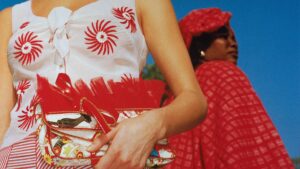 Both industries ultimately benefited from advancements in mass production techniques. This, in turn, allowed for the creation of more affordable and accessible clothing as well as accessories for a wider array of consumers. As any chic gal already knows, this exhibition totally reveals and emphasizes that there should be no delineation between fashion and jewelry as they definitely play an integral and inseparable role in self-fashioning. Thus, when considering fashion, one should encourage the art of processing when creating a wardrobe. Not only being cognizant of the garment selected but remembering that jewelry/ accessories are also an integral part of fashion and may play an important role in creating perfectly balanced results. FYI: Clothes that are encrusted and embellished with beads, sequins, and sparkles do blur the lines between each genre so one should be careful to “not guild the lily!”. The exhibition was organized by Emily Stoehrer, Rita J. Kaplan and Susan B. Kaplan Curator of Jewelry, and Theo Tyson, Curator of Fashion Arts. This myriad of new acquisitions along with a number of several pieces from the Museum’s existing fashion and jewelry collection may offer a rare opportunity as many things possibly have never been on view before. These include shoes and dresses from the collection of Donna Summer along with a ring created by Of Rare Origin, a version of which was worn by Amanda Gorman to the 2020 Presidential Inauguration. Spectacular loans include an ensemble from Iris Apfel from the Peabody Essex Museum and cuff bracelets designed by Fulco di Verdura for Gabrielle “Coco” Chanel. After visiting this exhibit, visitors will surely embrace the knowledge of how and where garments and accessories can—and do often —intersect. “Dress Up” is generously supported by The Coby Foundation, Northern Trust, and the David and Roberta Logie Fund for Textile and Fashion Arts. Additional support from the Loring Textile Gallery Exhibition Fund, and the Fashion Council. With gratitude to Leica Gallery & Store Boston. For more information and to register for the number of special events surrounding this exhibition that include lectures and courses, visit www.mfa.org
Both industries ultimately benefited from advancements in mass production techniques. This, in turn, allowed for the creation of more affordable and accessible clothing as well as accessories for a wider array of consumers. As any chic gal already knows, this exhibition totally reveals and emphasizes that there should be no delineation between fashion and jewelry as they definitely play an integral and inseparable role in self-fashioning. Thus, when considering fashion, one should encourage the art of processing when creating a wardrobe. Not only being cognizant of the garment selected but remembering that jewelry/ accessories are also an integral part of fashion and may play an important role in creating perfectly balanced results. FYI: Clothes that are encrusted and embellished with beads, sequins, and sparkles do blur the lines between each genre so one should be careful to “not guild the lily!”. The exhibition was organized by Emily Stoehrer, Rita J. Kaplan and Susan B. Kaplan Curator of Jewelry, and Theo Tyson, Curator of Fashion Arts. This myriad of new acquisitions along with a number of several pieces from the Museum’s existing fashion and jewelry collection may offer a rare opportunity as many things possibly have never been on view before. These include shoes and dresses from the collection of Donna Summer along with a ring created by Of Rare Origin, a version of which was worn by Amanda Gorman to the 2020 Presidential Inauguration. Spectacular loans include an ensemble from Iris Apfel from the Peabody Essex Museum and cuff bracelets designed by Fulco di Verdura for Gabrielle “Coco” Chanel. After visiting this exhibit, visitors will surely embrace the knowledge of how and where garments and accessories can—and do often —intersect. “Dress Up” is generously supported by The Coby Foundation, Northern Trust, and the David and Roberta Logie Fund for Textile and Fashion Arts. Additional support from the Loring Textile Gallery Exhibition Fund, and the Fashion Council. With gratitude to Leica Gallery & Store Boston. For more information and to register for the number of special events surrounding this exhibition that include lectures and courses, visit www.mfa.org
THROUGH APRIL 14: DINORA JUSTICE..THE LAY OF THE LAND
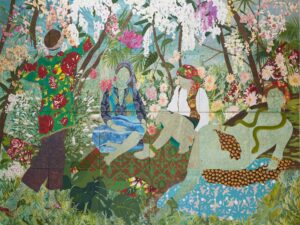 The Edward Linde Gallery at the MFA Boston hosts the works by the multidisciplinary artist Dinorá Justice. as she examines the place of women in traditional landscapes across the canon, The works in Justice’s exhibition were influenced by travel to Paris and Florence, Italy, to study gendered power dynamics in portrayals of women in nineteenth century paintings. The research journey was sponsored by an SMFA Traveling Fellowship that Justice received from her alma mater, the School of the Museum of Fine Arts at Tufts University (SMFA at Tufts).The SMFA Traveling Fellowships provide critical early-career support for SMFA at Tufts alumni, allowing them to further develop and inform their practice. Selected by a jury, SMFA Traveling Fellowship recipients receive up to $10,000 to pursue travel and research related to their art practice. The application process is open to alumni working in any contemporary visual art discipline. Justice’s exhibition is part of a long-standing collaboration between SMFA and the MFA. Dinorá Justice:
The Edward Linde Gallery at the MFA Boston hosts the works by the multidisciplinary artist Dinorá Justice. as she examines the place of women in traditional landscapes across the canon, The works in Justice’s exhibition were influenced by travel to Paris and Florence, Italy, to study gendered power dynamics in portrayals of women in nineteenth century paintings. The research journey was sponsored by an SMFA Traveling Fellowship that Justice received from her alma mater, the School of the Museum of Fine Arts at Tufts University (SMFA at Tufts).The SMFA Traveling Fellowships provide critical early-career support for SMFA at Tufts alumni, allowing them to further develop and inform their practice. Selected by a jury, SMFA Traveling Fellowship recipients receive up to $10,000 to pursue travel and research related to their art practice. The application process is open to alumni working in any contemporary visual art discipline. Justice’s exhibition is part of a long-standing collaboration between SMFA and the MFA. Dinorá Justice:
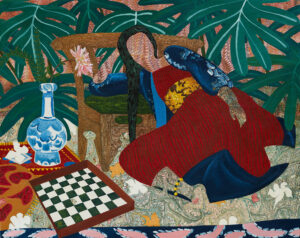 the chess board fashioned after Matisse. The Lay of the Land explores feminine figures, lush natural environments, and rich marbled patterns in strikingly original ways. Through her visual vocabulary, Justice considers how potent forces—women, nature, decoration—that have historically been laid claim to, destroyed, or disparaged might instead liberate, strengthen, and inspire. Justice married the research she conducted on her travels with her longstanding interest in eco-feminism to produce a body of work that asks the viewer to consider critically the ways in which femininity and the natural world have often been linguistically and culturally conjoined–and the consequences of this association. Her paintings are titled “after” works well known within the canon of Western art history by renowned nineteenth century European male artists, while her sculptures riff on ancient figurines that were often once boldly polychromatic and celebrated cycles of life. The artist uses verdant greenery, colorful Brazilian fabric designs, and hand marbled canvases to remix these quintessential art historical forms. The result rejects supine or sculptural feminine figures as symbols of colonized territory or fodder for the male eye as imagined by her predecessors. Instead, the artist’s use of pattern to anonymize and unify her subjects endows them with a degree of privacy and places them in interdependent dialogue with their outdoor settings. The title of this exhibition is taken from a book of the same name published almost 50 years ago by feminist historian Annette Kolodny. To understand “the lay of the land” is to know an environment, literally or figuratively, whether the natural world or the web of human relationships in which we move every day. Justice’s work invites the audience to consider the power relationships between artists, their subjects, and the wider world as stand-ins for our own relationships with gender and nature. It challenges viewers to consider what we have inherited—and what we want to perpetuate. Justice received her MFA from the School of the Museum of Fine Arts in 2014. “The Lay of the Land” is her first solo exhibition at the MFA. The exhibition is supported by SMFA at Tufts/Tufts University Art Galleries. For more information regarding SMFA (Tufts) and the MFA go to https://smfa.tufts.edu/.
the chess board fashioned after Matisse. The Lay of the Land explores feminine figures, lush natural environments, and rich marbled patterns in strikingly original ways. Through her visual vocabulary, Justice considers how potent forces—women, nature, decoration—that have historically been laid claim to, destroyed, or disparaged might instead liberate, strengthen, and inspire. Justice married the research she conducted on her travels with her longstanding interest in eco-feminism to produce a body of work that asks the viewer to consider critically the ways in which femininity and the natural world have often been linguistically and culturally conjoined–and the consequences of this association. Her paintings are titled “after” works well known within the canon of Western art history by renowned nineteenth century European male artists, while her sculptures riff on ancient figurines that were often once boldly polychromatic and celebrated cycles of life. The artist uses verdant greenery, colorful Brazilian fabric designs, and hand marbled canvases to remix these quintessential art historical forms. The result rejects supine or sculptural feminine figures as symbols of colonized territory or fodder for the male eye as imagined by her predecessors. Instead, the artist’s use of pattern to anonymize and unify her subjects endows them with a degree of privacy and places them in interdependent dialogue with their outdoor settings. The title of this exhibition is taken from a book of the same name published almost 50 years ago by feminist historian Annette Kolodny. To understand “the lay of the land” is to know an environment, literally or figuratively, whether the natural world or the web of human relationships in which we move every day. Justice’s work invites the audience to consider the power relationships between artists, their subjects, and the wider world as stand-ins for our own relationships with gender and nature. It challenges viewers to consider what we have inherited—and what we want to perpetuate. Justice received her MFA from the School of the Museum of Fine Arts in 2014. “The Lay of the Land” is her first solo exhibition at the MFA. The exhibition is supported by SMFA at Tufts/Tufts University Art Galleries. For more information regarding SMFA (Tufts) and the MFA go to https://smfa.tufts.edu/.
THROUGH APRIL 28: MONDRIAN…FOUNDATIONS
 Piet Mondrian, Beach with Five Piers at Domburg (1909). Gift of Maria and Conrad Janis by and through the Janis Living Trust The Museum of Fine Arts, Boston (MFA), exhibition of works by Piet Mondrian (1872–1944), celebrates a transformational gift that elevates the MFA to one of the leading institutions outside of the Netherlands for the study and display of the artist’s early work. Focusing on his early years, when he worked in a lesser known realistic style, this is the first monographic exhibition of Mondrian’s work presented at the MFA, On view are 11 paintings and 17 works on paper that span his entire career, Around 1920, Mondrian began to paint some of the most famous and recognizable artworks of the last century. These abstract paintings, characterized by white backgrounds, spare black lines and blocks of primary color, have become ubiquitous in today’s popular culture and are regarded as the heart of Mondrian’s achievement. But ironically, Mondrian’s artistic roots originated in Holland in the late 19th century where his paintings captured the characteristic Dutch landscape. Canals and windmills, fields and farmhouses, flowers and trees graced his canvases. Viewing those works side by side with his non-representational paintings, they reveal an artist who constantly reinvented himself as he absorbed new influences on his journey toward abstraction.
Piet Mondrian, Beach with Five Piers at Domburg (1909). Gift of Maria and Conrad Janis by and through the Janis Living Trust The Museum of Fine Arts, Boston (MFA), exhibition of works by Piet Mondrian (1872–1944), celebrates a transformational gift that elevates the MFA to one of the leading institutions outside of the Netherlands for the study and display of the artist’s early work. Focusing on his early years, when he worked in a lesser known realistic style, this is the first monographic exhibition of Mondrian’s work presented at the MFA, On view are 11 paintings and 17 works on paper that span his entire career, Around 1920, Mondrian began to paint some of the most famous and recognizable artworks of the last century. These abstract paintings, characterized by white backgrounds, spare black lines and blocks of primary color, have become ubiquitous in today’s popular culture and are regarded as the heart of Mondrian’s achievement. But ironically, Mondrian’s artistic roots originated in Holland in the late 19th century where his paintings captured the characteristic Dutch landscape. Canals and windmills, fields and farmhouses, flowers and trees graced his canvases. Viewing those works side by side with his non-representational paintings, they reveal an artist who constantly reinvented himself as he absorbed new influences on his journey toward abstraction.
A majority of the works in Mondrian: Foundations are drawn from a gift to the MFA from Maria and Conrad Janis by and through the Janis Living Trust. In addition to 34 paintings, drawings and watercolors by Mondrian—24 of which are on view in the exhibition—the gift included more than 200 works that significantly reshape the Museum’s holdings of early and mid-20th century art from Europe and the U.S. Highlights include a group of five sculptures by Jean Arp that enable the MFA to show the full chronological range of his work; works on paper by Fernand Léger, Alberto Giacometti, Paul Klee, Pablo Picasso and Franz Kline; the Museum’s first work by Anna Mary Moses (“Grandma Moses”); and a group of seven works by the self-taught artist Morris Hirshfield.
The late Conrad Janis (1928–2022) was a jazz trombonist and actor who starred in film and television during Hollywood’s “Golden Age” in the 1950s and 1960s. He inherited a major art collection from his father, renowned art dealer and writer Sidney Janis. In 2009, he gifted Composition with Blue, Yellow and Red—an important 1927 work by Mondrian that exemplifies his trademark style of pure geometries—to the MFA, making it the first painting by the artist to enter the Museum’s collection.
 Composition with Blue, Yellow and Red by Mondrian
Composition with Blue, Yellow and Red by Mondrian
Composition with Blue, Yellow and Red is the most recent work by Mondrian on view in the exhibition, which also features his earliest known painting, made when he was just 15 years old. This work, The Large Ponds in the Hague Forest (1887), is on loan to the MFA from Rose Marie and Eijk van Otterloo, longtime supporters of the Museum who are among the founders of the Center for Netherlandish Art, an innovative research center for the study and appreciation of Dutch and Flemish art. A landmark gift of 113 paintings from the 17th century, made in 2017 by the Van Otterloos and Susan and Matthew Weatherbie, elevated the MFA’s holdings to one of the premier collections of Dutch art in the world. The addition of modern works by Mondrian from the Janis collection complements the MFA’s holdings of 17th-century Dutch art, as well as its excellent collection of Dutch 19th- and 20th-century works on paper.
“Mondrian: Foundations” is supported by the Benjamin A. Trustman and Julia M. Trustman Fund. Visit www.mfa.org
THROUGH APRIL 28: CREATIVE SPACES…THE STUDIO AS INSPIRATION
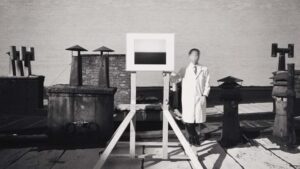 Sugimoto Hiroshi, Self-Portrait, 1990. Gelatin silver print. Gift of Sylvan Barnet and William Burto. © Hiroshi Sugimoto, courtesy Fraenkel Gallery, San Francisco. The Museum of Fine Arts in Boston presents this innovative and unique view of a photographer’s work space by utilizing 30 photographs from the 20th and 21st centuries that document photographers’ rarely seen studios. The exhibition explores the studio as a site of solitary invention for some photographers and, for others, an area activated by the presence of their subjects—whether children, backdrops, props, animals, or simply light. Florence Henri, Roger Ballen, and Robert Cumming mix natural and manmade elements in their work to produce simple tabletop arrangements while Rachel Perry and William Wegman use unconventional materials and methods. The breadth of photographers included in the exhibition represents the numerous processes and approaches to the medium, including multiple exposures, photo collages, cyanotypes, Polaroids, and digital prints. Thus, visitors can reflect on what sparks an artist’s imagination as well as the many different ways individual photographers have defined their studio. For more information, visit www.mfa.org
Sugimoto Hiroshi, Self-Portrait, 1990. Gelatin silver print. Gift of Sylvan Barnet and William Burto. © Hiroshi Sugimoto, courtesy Fraenkel Gallery, San Francisco. The Museum of Fine Arts in Boston presents this innovative and unique view of a photographer’s work space by utilizing 30 photographs from the 20th and 21st centuries that document photographers’ rarely seen studios. The exhibition explores the studio as a site of solitary invention for some photographers and, for others, an area activated by the presence of their subjects—whether children, backdrops, props, animals, or simply light. Florence Henri, Roger Ballen, and Robert Cumming mix natural and manmade elements in their work to produce simple tabletop arrangements while Rachel Perry and William Wegman use unconventional materials and methods. The breadth of photographers included in the exhibition represents the numerous processes and approaches to the medium, including multiple exposures, photo collages, cyanotypes, Polaroids, and digital prints. Thus, visitors can reflect on what sparks an artist’s imagination as well as the many different ways individual photographers have defined their studio. For more information, visit www.mfa.org
OPENING MAY 18: BEYOND BRILLIANCE: HIGHLIGHTS FROM THE JEWELERY COLLECTION
 Wallace Chan, Forever Dancing – Bright Star, 2013. Yellow diamond, fancy colored diamonds, rock crystal, mother-of-pearl, butterfly specimen, pearl, and titanium. Gift of Christin Xing and Rex Wong. Reproduced with permission. The newly renovated Rita J. and Stanley H. Kaplan Family Foundation Gallery features 150 highlights from the Museum’s world-renowned jewelry collection. The gallery spotlights ancient artifacts, fine jewelry, costume jewelry and jewelry by contemporary artists while exploring themes of decorative arts, adornment and messaging. Highlights include an ancient Egyptian broad collar necklace; 19th-century works by Castellani and Carlo Giuliano; 20th-century designs by Marcus & Co., Tiffany & Co., and Bulgari; René Boivin’s starfish brooch from 1937; and fashion jewelry by Chanel, Dior, and Elsa Peretti. Also featured are new acquisitions of contemporary jewelry by Christian and Yasmin Hemmerle, Wallace Chan and Feng J. With ornaments crafted over 4,000 years and reflecting global cultures, Beyond Brilliance: Highlights from the Jewelry Collection champions the great depth and breadth of the MFA’s collection. For more information visit www.mfa.org
Wallace Chan, Forever Dancing – Bright Star, 2013. Yellow diamond, fancy colored diamonds, rock crystal, mother-of-pearl, butterfly specimen, pearl, and titanium. Gift of Christin Xing and Rex Wong. Reproduced with permission. The newly renovated Rita J. and Stanley H. Kaplan Family Foundation Gallery features 150 highlights from the Museum’s world-renowned jewelry collection. The gallery spotlights ancient artifacts, fine jewelry, costume jewelry and jewelry by contemporary artists while exploring themes of decorative arts, adornment and messaging. Highlights include an ancient Egyptian broad collar necklace; 19th-century works by Castellani and Carlo Giuliano; 20th-century designs by Marcus & Co., Tiffany & Co., and Bulgari; René Boivin’s starfish brooch from 1937; and fashion jewelry by Chanel, Dior, and Elsa Peretti. Also featured are new acquisitions of contemporary jewelry by Christian and Yasmin Hemmerle, Wallace Chan and Feng J. With ornaments crafted over 4,000 years and reflecting global cultures, Beyond Brilliance: Highlights from the Jewelry Collection champions the great depth and breadth of the MFA’s collection. For more information visit www.mfa.org
THROUGH JULY 28: HALLYU!…THE KOREAN WAVE
 The Museum of Fine Arts Boston, in their Ann and Graham Gund Gallery, is hosting this exciting and innovative pop culture exhibition. Are you a fan of BTS and aespa? Have you seen the Oscar-winning film Parasite? Do you know every move to the “Gangnam Style” dance? From K-pop costumes to K-drama props and posters, photography and sculpture to fashion and video, delve into the phenomenon known as “hallyu”—meaning “Korean Wave.” Hallyu emerged as a sensation in the late 1990s, rippling across Asia before reaching all corners of the world and challenging the current of global popular culture today. This exhibition explores the makings of the Korean Wave through cinema, drama, music, and fandoms, and underlines its impact on the beauty and fashion industries. See close to 200 objects alongside pop-culture ephemera across four thematic spectrums—technology, cinema and drama, music, and fashion—engage with some of the biggest crazes to come out of hallyu through interactive displays, and discover the colorful and dynamic popular culture of South Korea in all its expanse. For more info, visit www.mfa.org
The Museum of Fine Arts Boston, in their Ann and Graham Gund Gallery, is hosting this exciting and innovative pop culture exhibition. Are you a fan of BTS and aespa? Have you seen the Oscar-winning film Parasite? Do you know every move to the “Gangnam Style” dance? From K-pop costumes to K-drama props and posters, photography and sculpture to fashion and video, delve into the phenomenon known as “hallyu”—meaning “Korean Wave.” Hallyu emerged as a sensation in the late 1990s, rippling across Asia before reaching all corners of the world and challenging the current of global popular culture today. This exhibition explores the makings of the Korean Wave through cinema, drama, music, and fandoms, and underlines its impact on the beauty and fashion industries. See close to 200 objects alongside pop-culture ephemera across four thematic spectrums—technology, cinema and drama, music, and fashion—engage with some of the biggest crazes to come out of hallyu through interactive displays, and discover the colorful and dynamic popular culture of South Korea in all its expanse. For more info, visit www.mfa.org
THROUGH SEPT. 29, 2024: TOSHIKO TAKAEZU…SHAPING ABSTRACTION
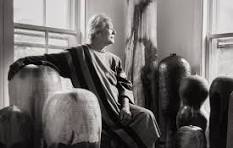 Bobby Jae Kim, Toshiko Takaezu (detail), 1997. Gelatin silver print. Montreal Museum of Fine Arts, Liliane and David M. Stewart Collection, gift of Bobby Jae Kim, D97.183.1. Image © Bobby J. Kim. The Museum of Fine Arts, Boston brings to the museum the highlights of works by Toshiko Takaezu (1922–2011). This technically masterful and innovative artist was born in Hawaii to parents of Okinawan ancestry. Regarding her her ceramic sculptures, her gestural style, distinctive palettes and complex layering of glazes align with the practices of Abstract Expressionists who were her contemporaries. Yet Takaezu added an element of chance as her pieces did not reveal their final colors until after they were fired. She often showed her ceramics in groups, sometimes with her equally innovative paintings and textiles, in carefully constructed arrangements that carefully responded to their environments. This fall, the Museum of Fine Arts, Boston (MFA) celebrates the extraordinary range of Takaezu’s work by tracing her development from potter to multimedia installation artist. This exhibition features a significant collection of Takaezu’s pottery which is shown alongside loans from private collections. In addition, the exhibition includes a a recent Museum acquisition of a large-scale weaving. This grouping of works demonstrates the artist’s cross-cultural interactions with contemporary Japanese ceramicists that occurred during her pivotal eight-month trip to Japan in 1955–56. In conjunction with the exhibition, additional displays on the third floor of the MFA’s Art of the Americas Wing and in the Linde Family Wing for Contemporary Art juxtapose Takaezu with two of her friends: the ceramic artist Leza McVey and sculptor Isamu Noguchi. With these challenging traditional presentations of American abstraction, the exhibition aims to make Takaezu’s contributions more widely known. It is organized in partnership with the Noguchi Museum and the Toshiko Takaezu Foundation. “Toshiko Takaezu” is supported by the Jean S. and Frederic A. Sharf Exhibition Fund, The Amy and Jonathan Poorvu Fund for the Exhibition of Contemporary Art and Sculpture, and the Eugenie Prendergast Memorial Fund. For more information visit www.mfa.org
Bobby Jae Kim, Toshiko Takaezu (detail), 1997. Gelatin silver print. Montreal Museum of Fine Arts, Liliane and David M. Stewart Collection, gift of Bobby Jae Kim, D97.183.1. Image © Bobby J. Kim. The Museum of Fine Arts, Boston brings to the museum the highlights of works by Toshiko Takaezu (1922–2011). This technically masterful and innovative artist was born in Hawaii to parents of Okinawan ancestry. Regarding her her ceramic sculptures, her gestural style, distinctive palettes and complex layering of glazes align with the practices of Abstract Expressionists who were her contemporaries. Yet Takaezu added an element of chance as her pieces did not reveal their final colors until after they were fired. She often showed her ceramics in groups, sometimes with her equally innovative paintings and textiles, in carefully constructed arrangements that carefully responded to their environments. This fall, the Museum of Fine Arts, Boston (MFA) celebrates the extraordinary range of Takaezu’s work by tracing her development from potter to multimedia installation artist. This exhibition features a significant collection of Takaezu’s pottery which is shown alongside loans from private collections. In addition, the exhibition includes a a recent Museum acquisition of a large-scale weaving. This grouping of works demonstrates the artist’s cross-cultural interactions with contemporary Japanese ceramicists that occurred during her pivotal eight-month trip to Japan in 1955–56. In conjunction with the exhibition, additional displays on the third floor of the MFA’s Art of the Americas Wing and in the Linde Family Wing for Contemporary Art juxtapose Takaezu with two of her friends: the ceramic artist Leza McVey and sculptor Isamu Noguchi. With these challenging traditional presentations of American abstraction, the exhibition aims to make Takaezu’s contributions more widely known. It is organized in partnership with the Noguchi Museum and the Toshiko Takaezu Foundation. “Toshiko Takaezu” is supported by the Jean S. and Frederic A. Sharf Exhibition Fund, The Amy and Jonathan Poorvu Fund for the Exhibition of Contemporary Art and Sculpture, and the Eugenie Prendergast Memorial Fund. For more information visit www.mfa.org
THROUGH NOV. 3: THINKING SMALL…DUTCH ART TO SCALE
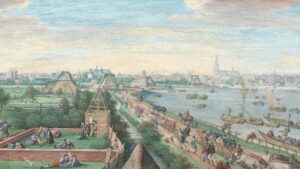 Hans Bol, View of Amsterdam from the South (detail), 1589. Gouache, heightened with gold, on vellum laid down on panel. Gift of Rose-Marie and Eijk van Otterloo in support of the Center for Netherlandish Art. A collaboration between the Center for Netherlandish Art at the MFA, the Yale University Art Gallery, and faculty and students at Yale, brought this exhibition to the MFA Boston. It explores an intriguing selection of objects from 17th-century Netherlands that were designed to elicit slow looking and contemplation on the part of their original audiences. With 15 paintings, prints, silver medals, books, and even a cup made from a carved nautilus shell, “Thinking Small: Dutch Art to Scale” compels viewers to reconsider their relationship to the world around them. Thus, the phrase “thinking small” describes an act of deep engagement with art—a specific kind of encounter in which a viewer considers, perceives, and acts differently in response to what they see. With some forms of Dutch art, the minute becomes all encompassing: tiny elements draw the eye and inspire viewers to engage at an intimate level, scrutinizing every inch and marveling at the skill and dedication of an object’s maker. In the 17th century, miniaturized representations of distance were a means for Dutch men and women to comprehend the vastness of their world. Though many works that invite the action of thinking small are small themselves, larger works can also invite viewers to focus on the particulars found within them. Dutch landscape painters often filled their compositions with details—real and imagined—that draw viewers into the world of the image. This is the third in a series of collaborations between the CNA and its academic partners that draws on the Museum’s deep collection of Dutch and Flemish art in new and unexpected ways, bringing fresh perspectives and diverse voices to the forefront while showcasing cross-disciplinary scholarship. The Founders of the Center for Netherlandish Art are Rose-Marie and Eijk van Otterloo and Susan and Matthew Weatherbie. For more information surrounding this exhibition in the William A. Coolidge Gallery (The Center for Netherlandish Art’s Gallery for Innovative Scholarship, visit www.mfa org
Hans Bol, View of Amsterdam from the South (detail), 1589. Gouache, heightened with gold, on vellum laid down on panel. Gift of Rose-Marie and Eijk van Otterloo in support of the Center for Netherlandish Art. A collaboration between the Center for Netherlandish Art at the MFA, the Yale University Art Gallery, and faculty and students at Yale, brought this exhibition to the MFA Boston. It explores an intriguing selection of objects from 17th-century Netherlands that were designed to elicit slow looking and contemplation on the part of their original audiences. With 15 paintings, prints, silver medals, books, and even a cup made from a carved nautilus shell, “Thinking Small: Dutch Art to Scale” compels viewers to reconsider their relationship to the world around them. Thus, the phrase “thinking small” describes an act of deep engagement with art—a specific kind of encounter in which a viewer considers, perceives, and acts differently in response to what they see. With some forms of Dutch art, the minute becomes all encompassing: tiny elements draw the eye and inspire viewers to engage at an intimate level, scrutinizing every inch and marveling at the skill and dedication of an object’s maker. In the 17th century, miniaturized representations of distance were a means for Dutch men and women to comprehend the vastness of their world. Though many works that invite the action of thinking small are small themselves, larger works can also invite viewers to focus on the particulars found within them. Dutch landscape painters often filled their compositions with details—real and imagined—that draw viewers into the world of the image. This is the third in a series of collaborations between the CNA and its academic partners that draws on the Museum’s deep collection of Dutch and Flemish art in new and unexpected ways, bringing fresh perspectives and diverse voices to the forefront while showcasing cross-disciplinary scholarship. The Founders of the Center for Netherlandish Art are Rose-Marie and Eijk van Otterloo and Susan and Matthew Weatherbie. For more information surrounding this exhibition in the William A. Coolidge Gallery (The Center for Netherlandish Art’s Gallery for Innovative Scholarship, visit www.mfa org
THROUGH DEC. 13, 2026: INTENTIONAL BEAUTY…JEWISH RITUAL ART FROM THE COLLECTION
 Elimelekh Tzoref, Torah shield, 1781–82. Silver and parcel gilt with enamel, niello, and stones. Museum purchase with funds donated by the Phillip Leonian and Edith Rosenbaum Leonian Charitable Trust, Jacques Aaron Preis, Trustee. The Museum of Fine Arts, Boston (MFA), opens Intentional Beauty: Jewish Ritual Art from the Collection in the Bernard and Barbara Stern Shapiro Gallery in the Art of the Americas Wing. It is the first gallery devoted to Jewish ritual art, or Judaica, at the MFA and in New England. Bringing together 27 objects from Asia, North Africa, Europe and the U.S., the gallery showcases ceremonial items created for the Jewish religious experience that were utilized both at home and in the synagogue. Twenty of these objects are on view at the MFA for the first time. The vast majority of new acquisitions speak to the remarkable geographic and cultural diversity of the Jewish people. This new installation features metalwork, textiles, paintings, furniture and works on paper. This newly dedicated space complements the MFA’s longstanding commitment to integrating Judaica objects and stories across the Museum’s collection galleries, creating dialogues with different cultures and inviting visitors to deepen their engagement. This exhibition is sponsored by the David Berg Foundation. Additional support provided by Lorraine Bressler, the Rita J. and Stanley H. Kaplan Family Foundation, Inc., Lisbeth Tarlow and Stephen Kay, and The Priebatsch Family Fund, in loving memory of Norman Priebatsch. With special gratitude to Marcia and Louis Kamentsky and the Charles and Lynn Schusterman Family Foundation. For more information visit www.mfa.org
Elimelekh Tzoref, Torah shield, 1781–82. Silver and parcel gilt with enamel, niello, and stones. Museum purchase with funds donated by the Phillip Leonian and Edith Rosenbaum Leonian Charitable Trust, Jacques Aaron Preis, Trustee. The Museum of Fine Arts, Boston (MFA), opens Intentional Beauty: Jewish Ritual Art from the Collection in the Bernard and Barbara Stern Shapiro Gallery in the Art of the Americas Wing. It is the first gallery devoted to Jewish ritual art, or Judaica, at the MFA and in New England. Bringing together 27 objects from Asia, North Africa, Europe and the U.S., the gallery showcases ceremonial items created for the Jewish religious experience that were utilized both at home and in the synagogue. Twenty of these objects are on view at the MFA for the first time. The vast majority of new acquisitions speak to the remarkable geographic and cultural diversity of the Jewish people. This new installation features metalwork, textiles, paintings, furniture and works on paper. This newly dedicated space complements the MFA’s longstanding commitment to integrating Judaica objects and stories across the Museum’s collection galleries, creating dialogues with different cultures and inviting visitors to deepen their engagement. This exhibition is sponsored by the David Berg Foundation. Additional support provided by Lorraine Bressler, the Rita J. and Stanley H. Kaplan Family Foundation, Inc., Lisbeth Tarlow and Stephen Kay, and The Priebatsch Family Fund, in loving memory of Norman Priebatsch. With special gratitude to Marcia and Louis Kamentsky and the Charles and Lynn Schusterman Family Foundation. For more information visit www.mfa.org
CURRENTLY: MICHAELINA WAUTIER EXHIBITION IN THE AMERICAS
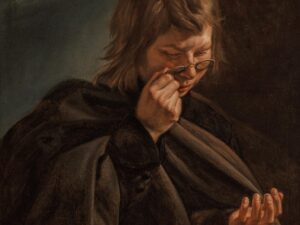 The Center for Netherlandish Art at the Museum of Fine Arts, Boston presents the first exhibition in the Americas dedicated to the art of Michaelina Wautier (1614–1689), a painter from Brussels all but forgotten until the recent rediscovery of her work. Now on view, the exhibition is centered around her rare series The Five Senses (1650), a set of five pictures that were virtually unknown until it was acquired by Rose-Marie and Eijk van Otterloo and lent to the MFA in 2020. They are joined by Wautier’s remarkable Self-Portrait (above) on loan from a private collection and on public view in the U.S. for the first time. Wautier’s technique, process and training are mysterious. Few records about her life exist, due in part to her gender. This exhibition, organized by the MFA’s Center for Netherlandish Art in collaboration with a professor and six doctoral students from Brown University, presents new scholarship about the artist and her unusual career as a female painter working in mid-17th-century Brussels. The Five Senses and the Self-Portrait, all of which have only been attributed to Wautier in recent years, are among fewer than 40 known works by the artist. Wautier focuses on boys—a different model in each painting—performing everyday activities in her detailed portrayals of Sight, Hearing, Smell, Taste and Touch. Accompanying prints by her predecessors and contemporaries, including Cornelis Cort (1533–1578) and Johannes Gillisz. van Vliet (about 1610–about 1640), demonstrate Wautier’s originality, showcasing how she defied a convention at the time of depicting the senses as experienced by idealized women. In her Self-Portrait, Wautier presents herself both in a formal aristocratic setting and as a professional artist, facing an easel and holding painting tools. Together, these extraordinary pictures are exemplary of Wautier’s unique style and brushwork. Additionally, the exhibition features a print after a now-lost portrait by Wautier from the MFA’s collection that has never been on view. Michaelina Wautier and the Five Senses: Innovation in 17th-Century Flemish Painting is accompanied by the first volume of the digital publication series CNA Studies, available on mfa.org and featuring essays by the six organizing students: Yannick Etoundi, Sophie Higgerson, Emily Hirsch, Regina Noto, Mohadeseh Salari Sardari and Dandan Xu is edited by Professor Jeffrey Muller. The exhibition and the Center for Netherlandish Art’s Gallery for Innovative Scholarship is sponsored by Northern Trust. Additional support from the Government of Flanders – Flanders Investment & Trade. Further information may be found at www.mfa.org
The Center for Netherlandish Art at the Museum of Fine Arts, Boston presents the first exhibition in the Americas dedicated to the art of Michaelina Wautier (1614–1689), a painter from Brussels all but forgotten until the recent rediscovery of her work. Now on view, the exhibition is centered around her rare series The Five Senses (1650), a set of five pictures that were virtually unknown until it was acquired by Rose-Marie and Eijk van Otterloo and lent to the MFA in 2020. They are joined by Wautier’s remarkable Self-Portrait (above) on loan from a private collection and on public view in the U.S. for the first time. Wautier’s technique, process and training are mysterious. Few records about her life exist, due in part to her gender. This exhibition, organized by the MFA’s Center for Netherlandish Art in collaboration with a professor and six doctoral students from Brown University, presents new scholarship about the artist and her unusual career as a female painter working in mid-17th-century Brussels. The Five Senses and the Self-Portrait, all of which have only been attributed to Wautier in recent years, are among fewer than 40 known works by the artist. Wautier focuses on boys—a different model in each painting—performing everyday activities in her detailed portrayals of Sight, Hearing, Smell, Taste and Touch. Accompanying prints by her predecessors and contemporaries, including Cornelis Cort (1533–1578) and Johannes Gillisz. van Vliet (about 1610–about 1640), demonstrate Wautier’s originality, showcasing how she defied a convention at the time of depicting the senses as experienced by idealized women. In her Self-Portrait, Wautier presents herself both in a formal aristocratic setting and as a professional artist, facing an easel and holding painting tools. Together, these extraordinary pictures are exemplary of Wautier’s unique style and brushwork. Additionally, the exhibition features a print after a now-lost portrait by Wautier from the MFA’s collection that has never been on view. Michaelina Wautier and the Five Senses: Innovation in 17th-Century Flemish Painting is accompanied by the first volume of the digital publication series CNA Studies, available on mfa.org and featuring essays by the six organizing students: Yannick Etoundi, Sophie Higgerson, Emily Hirsch, Regina Noto, Mohadeseh Salari Sardari and Dandan Xu is edited by Professor Jeffrey Muller. The exhibition and the Center for Netherlandish Art’s Gallery for Innovative Scholarship is sponsored by Northern Trust. Additional support from the Government of Flanders – Flanders Investment & Trade. Further information may be found at www.mfa.org
IN ADDITION THERE ARE OVER 26 ONGOING GALLERY HIGHLIGHTS TO EXPLORE AT THE MFA…
>>>>>>>>>>>>>>>>>>>>>>>>>>>>>>>>>>>>>>>
ISABELLA STEWART GARDENER MUSEUM
See complete museum information under “MUSEUMS” www.gardnermuseum.org
THROUGH MAY 12: RAQIB SHAW: BALLADS OF EAST AND WEST
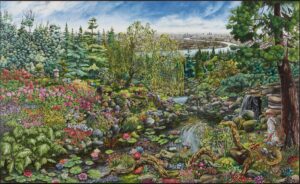 The Isabella Stewart Gardner Museum, 25 Evans Way in Boston hosts this stunning immersion exhibition that was co-curated with noted historian and curator, Dr. Zehra Jumabhoy that was originally organized by the Frist Museum in Nashville, TN. This exhibition proffers an invitation to visitors to see the world as versioned by Raqib Shaw. He refers to the world as, “An amalgamation, a hybrid, a cocktail.” Thus the Gardner Museum has chosen to unfold them across three locations of the museum. First on notes the newly commissioned work that has been placed on the Anne H. Fitzpatrick façade of the contemporary wing. Next, visitors can take a deep dive into Shaw’s process in the Palace’s Fenway Gallery. Finally, viewers are drawn to the Hostetter Gallery in the New Building to embrace twelve years of paintings by Shaw. Similar to Shaw’s view on the world, visitors will realize as Shaw encourages, “The more you look, the more it will reward you.” Raqib Shaw is an internationally renowned painter who has leaned toward reinventing paintings by the great masters.
The Isabella Stewart Gardner Museum, 25 Evans Way in Boston hosts this stunning immersion exhibition that was co-curated with noted historian and curator, Dr. Zehra Jumabhoy that was originally organized by the Frist Museum in Nashville, TN. This exhibition proffers an invitation to visitors to see the world as versioned by Raqib Shaw. He refers to the world as, “An amalgamation, a hybrid, a cocktail.” Thus the Gardner Museum has chosen to unfold them across three locations of the museum. First on notes the newly commissioned work that has been placed on the Anne H. Fitzpatrick façade of the contemporary wing. Next, visitors can take a deep dive into Shaw’s process in the Palace’s Fenway Gallery. Finally, viewers are drawn to the Hostetter Gallery in the New Building to embrace twelve years of paintings by Shaw. Similar to Shaw’s view on the world, visitors will realize as Shaw encourages, “The more you look, the more it will reward you.” Raqib Shaw is an internationally renowned painter who has leaned toward reinventing paintings by the great masters.
 For years, the now 50 year old Shaw has artfully articulated a dialogue between East and West. At 29 years of age, Shaw had his first major solo show and has continued to ride toward stellar heights since then. Based in London, the artist lived most of his childhood in the Indian city of Srinagar, a ‘Heaven on Earth’ encircled by pristine Himalayan mountains, crystal lakes, and exquisite gardens. Now, marred by political insurgencies, his magical Kashmir he knew as a child no longer exists. For Shaw, Kashmir represents a trampled Eden—a paradise lost—and references to the beauty and trauma of his childhood abound in his work. His works are flamboyant, fantastical, and extremely labor-intensive.
For years, the now 50 year old Shaw has artfully articulated a dialogue between East and West. At 29 years of age, Shaw had his first major solo show and has continued to ride toward stellar heights since then. Based in London, the artist lived most of his childhood in the Indian city of Srinagar, a ‘Heaven on Earth’ encircled by pristine Himalayan mountains, crystal lakes, and exquisite gardens. Now, marred by political insurgencies, his magical Kashmir he knew as a child no longer exists. For Shaw, Kashmir represents a trampled Eden—a paradise lost—and references to the beauty and trauma of his childhood abound in his work. His works are flamboyant, fantastical, and extremely labor-intensive.
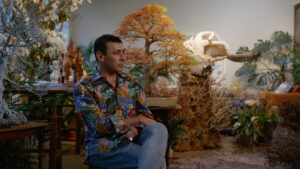 They are puzzles that always include certain key ingredients: self-portraiture, landscapes in peril, references to historic painting, or moments from his own life. Shaw frequently depicts himself as satyr, a joker, a saint, a philosopher, or a blue-skinned divinity clad in sumptuous robes. The sensuous, glossy intensity of the jewel-like painting surface is rendered in infinite colors and shades with painstaking technique rendered in enamel paint, applied with porcupine quills to birch wood panels. From Boston, Raqib Shaw: Ballads of East and West will head to The Museum of Fine Arts in Houston, Texas from June 9 through September 2, 2024 and then on to he Huntington Library, Art Museum and Botanical Gardens in San Marino, California from November 15, 2024 through March 20, 2025. For more information surrounding this and other exhibits as well as scheduled events, visit www.gardnermuseum.org
They are puzzles that always include certain key ingredients: self-portraiture, landscapes in peril, references to historic painting, or moments from his own life. Shaw frequently depicts himself as satyr, a joker, a saint, a philosopher, or a blue-skinned divinity clad in sumptuous robes. The sensuous, glossy intensity of the jewel-like painting surface is rendered in infinite colors and shades with painstaking technique rendered in enamel paint, applied with porcupine quills to birch wood panels. From Boston, Raqib Shaw: Ballads of East and West will head to The Museum of Fine Arts in Houston, Texas from June 9 through September 2, 2024 and then on to he Huntington Library, Art Museum and Botanical Gardens in San Marino, California from November 15, 2024 through March 20, 2025. For more information surrounding this and other exhibits as well as scheduled events, visit www.gardnermuseum.org

>>>>>>>>>>>>>>>>>>>>>>>>>>>>>>>>>>>>>>
INSTITUTE OF CONTEMPORARY ART
www.icaboston.org See complete museum information under “MUSEUMS”
>>>>>>>>>>>>>>>>>>>>>>>>>>>>>>>>>>>>>>>>
GALLERIES ONGOING: LANOUE FINE ART GALLERY
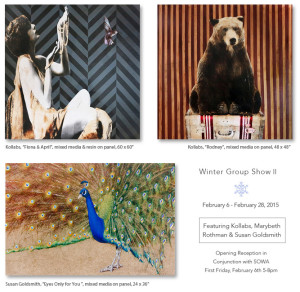 Located at 450 Harrison Ave. #31 in Boston (At Thayer Street, on the ground level), in the SOWA ART DISTRICT, this well established gallery hosts outstanding contemporary artists from around the world. For more information about current and up and coming artists go to www.LanoueGallery.com
Located at 450 Harrison Ave. #31 in Boston (At Thayer Street, on the ground level), in the SOWA ART DISTRICT, this well established gallery hosts outstanding contemporary artists from around the world. For more information about current and up and coming artists go to www.LanoueGallery.com
ONGOING: MOVIMIENTO GALLERY
 Paul Walcott “Triple Entendre” Paul Walcott has established a new Gallery space in the dynamic SOWA art’s district at 450 Harrison Ave, 4th Floor, Suite #401, in Boston. He invites all to this new Gallery space in the dynamic SOWA art’s district in Boston! Each month, the Gallery features some of the most talented and innovative artists in New England as well as ongoing displays of art furniture. MOVIMIENTO is also the home of Tango Embrace, where they host a variety of tango events including workshops and private classes. For more information go to www.MOVIMIENTOspace.com.
Paul Walcott “Triple Entendre” Paul Walcott has established a new Gallery space in the dynamic SOWA art’s district at 450 Harrison Ave, 4th Floor, Suite #401, in Boston. He invites all to this new Gallery space in the dynamic SOWA art’s district in Boston! Each month, the Gallery features some of the most talented and innovative artists in New England as well as ongoing displays of art furniture. MOVIMIENTO is also the home of Tango Embrace, where they host a variety of tango events including workshops and private classes. For more information go to www.MOVIMIENTOspace.com.
